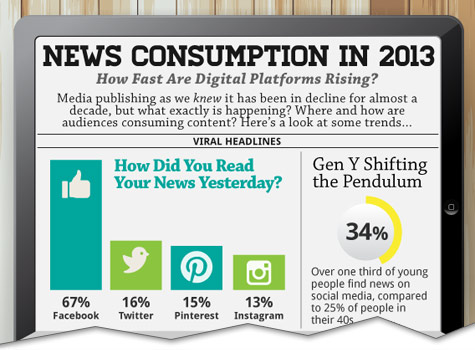Traditional news sources are being challenged by social media in engaging the public with news and current events. In the forefront, Facebook stands as the powerhouse among social media forums.
According to a Pew Research Center report from 2013, most Americans obtain “drive-by news” on Facebook in which they learn of current events as a byproduct of other activities they engage in while on the site. Yet, the consumption of news via social media in recent years has actually bypassed the characterization of “drive-by news” and has entered into a new period of deeper engagement.
News articles from major sources are constantly uploaded, shared, retweeted and regrammed on social media platforms. Personal blogs and op-eds have found a home in social media along with individual posts that call for discussion and even debate among users.
In an article titled “Facebook Top Source for Political News Among Millennials,” published by the Pew Research Center in June of this year, it was stated that ‘Millennials’ reliance on Facebook for political news is also almost exactly on par with Baby Boomers’ reliance on local TV (60%).’
So, what does this mean for news consumption? To be stated simply, it is becoming more accessible and diversified within the realm of social media.
Not only is this affecting the way consumers take in news but also how producers are creating news.
Brandon Stanton, the man behind Humans of New York, for example, took his passion for photography and expanded it into a global phenomenon that has touched millions of lives. Stanton, who began by showcasing photos and interviews with, as you can guess, humans of New York on his Facebook page, has expanded his practice into a political personality.
On December 2 at 9:18 am, Stanton posted on his Humans of New York Facebook page that he had recently returned from Jordan and Turkey, where he had the opportunity to interview 12 Syrian refugee families who have been cleared for resettlement in the United States.
In both traditional sources of news and social media, the subject of Syrian refugees coming to the United States has been extremely controversial. The White House had stated that it was willing to accept 10,000 refugees within the next fiscal year, which began on October 1.
Compared to other countries, this is a small number to be accepted. In the 2015 fiscal year, the U.S. accepted 70,00 refugees but only 1,500 of those were from Syria. To put this into perspective, the United Nations estimates that there are four million Syrian refugees.
As Europe continues to become the face of the global crisis in which it has already accepted over 350,000 refugees seeking asylum, the U.S. is considered by the international community to be a bystander of the crisis. Senators across the nation declared that they would not allow Syrian refugees to enter their states. Facebook posts immediately flooded the internet, claiming that the United States should not accept refugees if it could not even get its veterans off the streets.
The American reaction was overwhelming and in many ways, negative and heartless. Terrorism became a concern and once again, anti-Islamic sentiments filled the minds of many westerners.
Stanton’s efforts in sharing the stories of these 12 Syrian families gives light to a new perspective on the refugee crisis. It shows the evidence of heartbreak, tragedy and pure pain that these families have gone through. It highlights the struggles of brothers and parents, of students and doctors, of the past and the future.
Yet, hope still manages to shine through in Stanton’s stories. These families, whose stories are so personal and might not have been covered by traditional news sources or shared with so many viewers, have impacted how Americans, in particular, are understanding the refugee crisis.
Beyond the change in which the news is being obtained, it has also changed the way we draw conclusions about the world around us.
